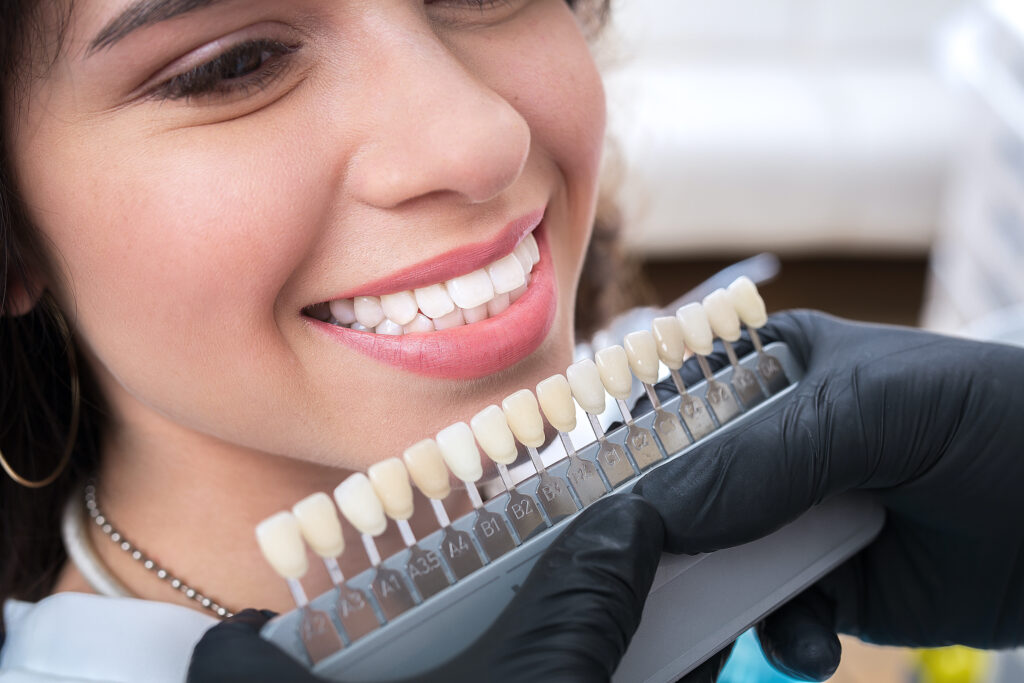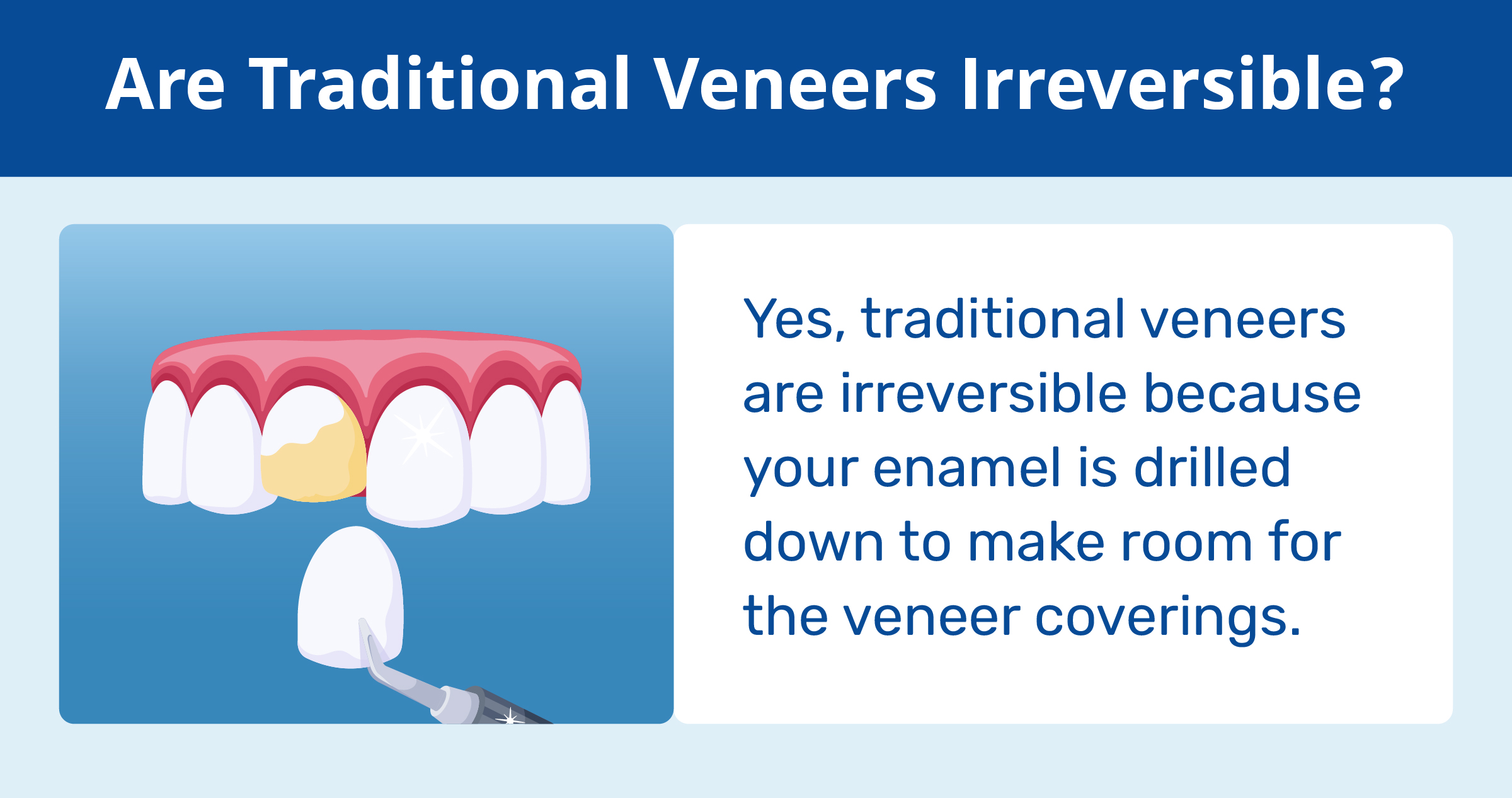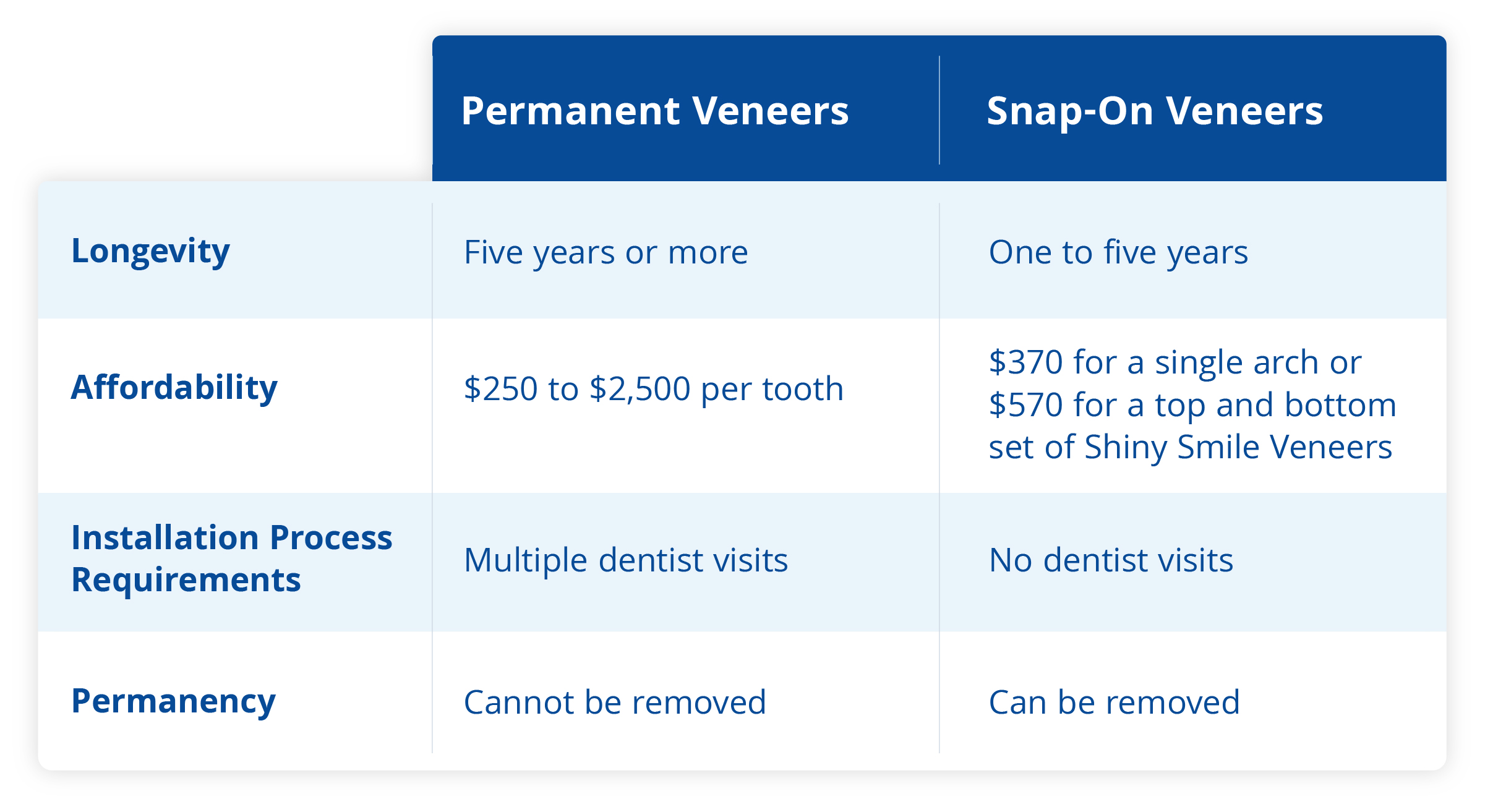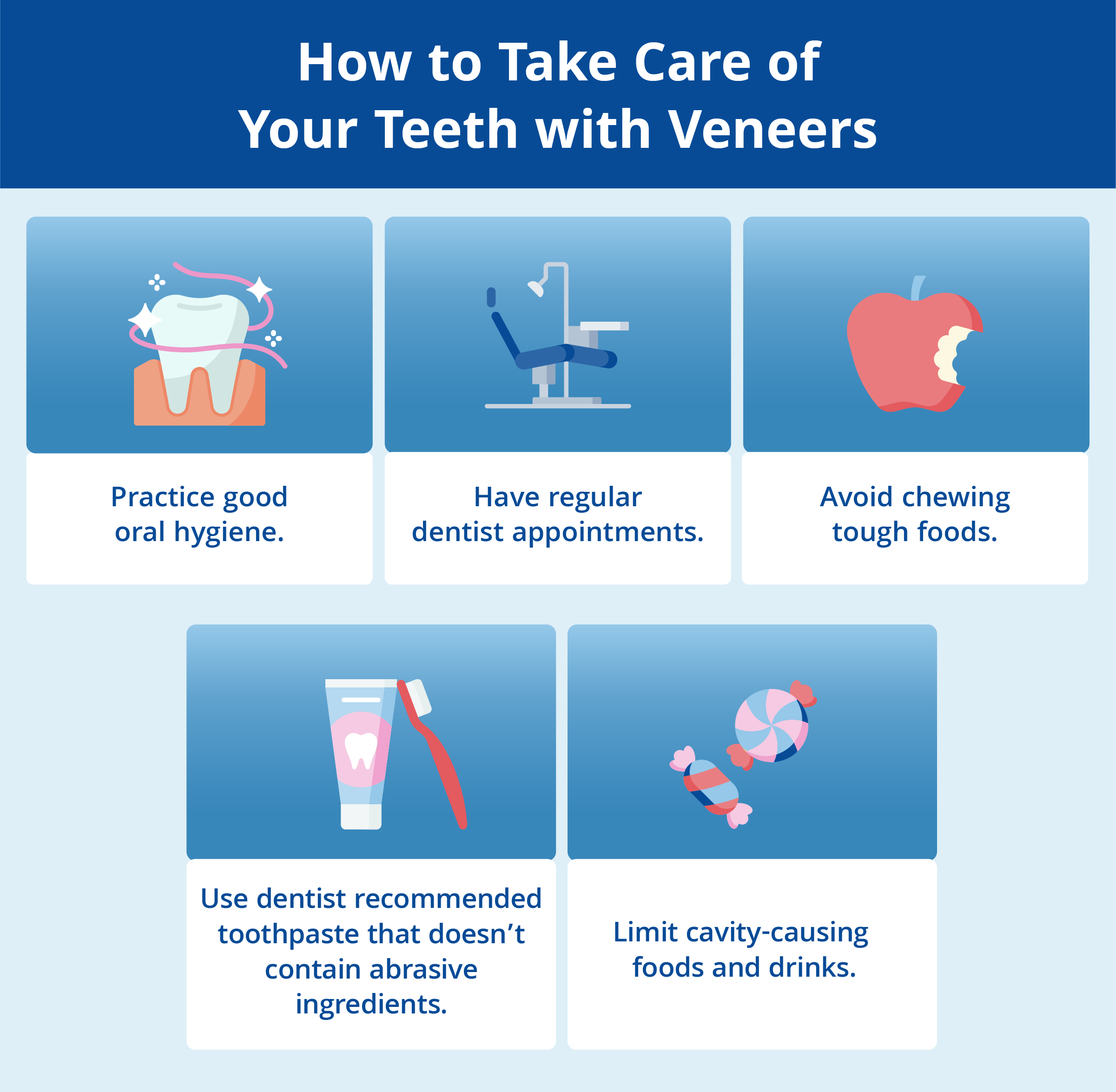

Dental veneers can help with a wide variety of tooth-related issues, helping your teeth look whiter or straighter.
While veneers aren’t exactly bad for your teeth, the traditional veneers procedure involves the process of shaving down your tooth enamel to make room for the veneer coverings. Once the enamel is gone, it doesn’t grow back, meaning this process is permanent. You can’t go back to your natural teeth once you’ve gotten traditional veneers — you’ll care for your veneers just like you would real teeth.

If veneers are installed incorrectly, you could experience tooth decay underneath them from food particles and other bacteria getting trapped. But this is by no means a standard result, and a correctly performed veneers procedure shouldn’t have this effect.
Snap-on veneers, or temporary veneers, have the least impact on your natural teeth. They don’t affect your enamel and aren’t bonded to your teeth. You can take them out and brush your natural teeth as you regularly would. The only potential downside is that they’re not a permanent, long-lasting option.
In this post, we go over how different types of veneers can affect your teeth and oral health, and how to have the best outcome for your smile makeover.
Do Veneers Ruin Your Teeth?
Veneers themselves don’t ruin your teeth, but preparing teeth for traditional veneers causes irreversible changes because a dental professional must remove a thin layer of natural enamel from your teeth surfaces. That’s why veneers are permanent, and you can’t go back to your natural teeth once you get them.
You’ll need to replace your veneers as they wear down over time. Composite veneers typically have a lifespan of five years or more, while porcelain veneers last 10 or more.
If your veneers are applied correctly, and you continue practicing good oral hygiene, then you shouldn’t experience any major oral health issues, including your teeth decaying under permanent veneers.
If you get no-prep veneers, a semi-permanent type, your enamel isn’t removed. However, the dental cement used to bond the veneers to your enamel can still damage your teeth if you remove the veneers.
What Is the Process of Getting Permanent Veneers?
Getting permanent veneers installed is a multi-step process, involving a few visits to the dentist. Here’s an overview of how it typically happens.
1. Visit Your Dentist to Ensure Your Teeth are Suitable for Veneers
First, you’ll need to ensure that your teeth are suitable for veneers. Certain dental issues aren’t appropriate for veneers — they don’t fix missing teeth, serious oral health issues, severe tooth misalignment, extreme cavities, or gum disease.
You’re usually a good candidate for veneers if you have cracked, chipped or broken teeth, crooked teeth, gaps in your teeth, worn-down teeth, or tooth discoloration. Consult with your dentist first to ensure they’re a good treatment option for you.
2. Get X-Rays, Impressions, and Photographs of Your Teeth
Next, you’ll need to get x-rays, impressions, and photographs taken of your teeth so that your dentist knows what they’re working with. At this stage, you can also talk with your dentist about what you want the veneers to look like, including shape, color, width, and more.
3. The Dentist Will Prepare Your Teeth for Veneers
At your next appointment, your dentist will prepare your teeth for the veneers by drilling down your enamel, just enough for the new coverings to be placed on top of the teeth.
They will then take an impression of your teeth, and send that to a lab to process and create your customized veneers. You’ll receive temporary veneers to wear while you await your permanent ones.
4. Schedule Your Veneer Appointment
Finally, at your last appointment, you’ll get your permanent veneers installed. Remember, as the name suggests, this is a permanent procedure — you can’t undo it once you get it done.
Your dentist will bond the veneers to the enamel of your teeth. Once they’re on, you’ll schedule follow-up dental care as normal, getting them replaced periodically when they become dull, stained, or chipped. If you get porcelain veneers, they’ll typically last at least 10 years. Veneers made of composite resin are slightly less durable, lasting around five years.
Are Your Teeth Suitable for Veneers?
Consulting with your dentist is the best way to find out if veneers are right for you.
Typically, you’re a good candidate for veneers if:
- You have cracked or chipped teeth.
- You have gaps between your teeth.
- You have crooked teeth.
- You have stained or discolored teeth.
You might not be suitable for veneers if:
- You have missing teeth.
- You have many cavities or gum disease.
- You have serious oral health issues.
- You have severe tooth alignment issues.
The Risks of Getting Veneers
Veneers are generally safe to get if you’re in good oral health and have healthy gums. Having a healthy foundation is important for veneers since they’re more of a cosmetic dental treatment and can’t address profound oral health issues.
In a standard traditional or permanent veneers procedure, the main effect on your natural teeth is that they’re shaved down so the coverings can fit. This is irreversible, and you can’t go back to your original teeth once this part of the procedure is complete.
If they’re applied incorrectly, traditional or permanent veneers can damage your teeth and cause issues like:
- Tooth decay caused by food or bacteria getting stuck between the teeth and veneers
- Cracks in your teeth from the thickness of veneers
- Teeth sensitivity due to drilling down the enamel
Can You Go Back to Your Teeth After Veneers?
Generally, you cannot go back to your original teeth after you get permanent veneers because enamel removal is irreversible, affecting your actual tooth structure as well as how your teeth look. You also might not be able to reverse no-prep veneers, because the bonding agent used in the process could hurt your enamel if you try to remove the veneers.
If your permanent veneers get damaged or chipped, like from eating something too hard or sticky, you’ll need to get your veneers replaced by your dentist.
You can go back to your real teeth if you’re using temporary veneers, like snap-on veneers.
Pros and Cons of Traditional Veneers
Traditional porcelain veneers are the gold standard for dental veneers. But, like anything else, they have their advantages and disadvantages. Here are some of the main pros and cons.
Pros
- Natural appearance: Porcelain veneers look the most like real teeth, providing the most natural appearance of all the options.
- Durable: They tend to last the longest, usually at least 10 years or more.
- Stain resistant: Porcelain is naturally resistant to stains from food and drinks.
- Customizable: You can choose how you want your veneers to look in terms of color, width, and shape. You also can get individual or partial veneers if you don’t need a full set.
Cons
- Irreversible: The procedure involves shaving down your enamel, meaning you can’t return to your original teeth once you get traditional veneers installed.
- Expensive: Porcelain veneers are very expensive, costing anywhere from $925 to $2,500 per tooth.
- Maintenance: In addition to standard oral hygiene, you may need to take extra care to maintain your veneers, such as avoiding hard or sticky foods that can damage them.
- Installation prep: It takes multiple dentist visits, including imaging, drilling down your teeth, waiting for your veneers to be made, and actually getting them installed to get permanent veneers put in.
Permanent vs. Temporary Veneers
Permanent veneers aren’t the only option. If you’re looking for a way to improve how your teeth look, temporary or snap-on veneers might be a great, cost-effective alternative.

The main difference is that, unlike traditional veneers, temporary veneers are reversible — simply snap them on when you want them on, and snap them off when you want to go back to your original teeth.
Here are some other key ways temporary veneers differ from permanent ones:
- Temporary veneers don’t require drilling of your teeth enamel like permanent veneers.
- Temporary veneers won’t last as long as permanent veneers.
- Temporary veneers are more affordable than permanent veneers.
- Temporary veneers’ installation process is easier than permanent veneers.
- Temporary veneers don’t require as much maintenance as permanent veneers.
How to Take Care of Your Teeth with Veneers
Whether it’s veneers or your natural teeth, proper care and good oral hygiene is important. While veneers might “replace” your real teeth, they still need consistent dental care, and you can still get cavities or even tooth decay with veneers.

Here’s how to take care of your veneers:
- Practice good oral hygiene: Care for your teeth by brushing and flossing daily. When you brush, try to brush each section of your teeth for 30 seconds (or two minutes total) and use the brush at a 45-degree angle.
- Use toothpaste without abrasive ingredients: Abrasive agents can scratch or wear down your veneers, causing them to weaken or lose their shine.
- Use a soft toothbrush: Just like a too-abrasive toothpaste, a hard-bristled toothbrush can ruin the polish of your veneers.
- Have regular dentist appointments: Routine checkups will both keep your teeth clean, remove any plaque buildup between appointments, and allow your dentist to check your teeth for any signs of oral health problems.
- Avoid chewing tough objects: Veneers are prone to damage, like cracking, if you bite down on something that’s too hard.
- Limit cavity-causing foods and drinks: Just like with your real teeth, you should avoid eating too much sugary or acidic food since these can encourage wear and decay.
Try Snap-On Veneers Today
If you want a straighter, whiter smile that’s easy on your teeth and your wallet, snap-on veneers can be a good temporary or long-term solution.
Ordering from Shiny Smile Veneers is easy. Just follow these four steps:
- Place your order. Use the impressions kit we send you to make impressions of your teeth.
- Take pictures of your teeth. We provide instructions for what images to provide.
- Mail in your impression kit.
- Receive your very own custom veneers in the mail.
A full top and bottom set of snap-on veneers costs $570, while a single arch costs $370. Best of all, since they’re snap-on, they won’t permanently affect your natural teeth — so you can try veneers without going through any irreversible changes.
So if you’re ready to get a beautiful smile that won’t break the bank, order your set of Shiny Smile Veneers today.
